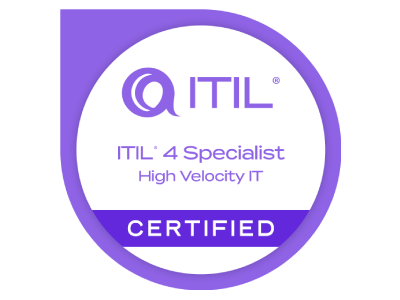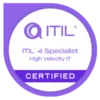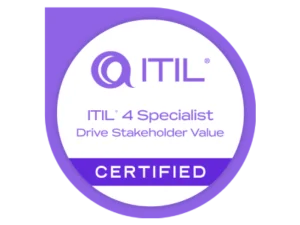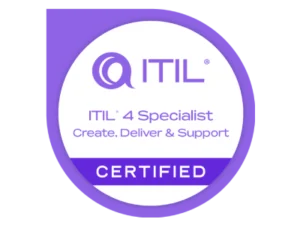ITIL® 4 Specialist: High-velocity IT
You will learn about technologies like cloud computing and automation testing, as well as working methods like agile and lean management, in this ITIL 4 Specialist: HVIT course. ITIL Strategic Leaders (ITIL SLs) and ITIL Managing Professionals (ITIL MPs), who strive to deliver high velocity-IT, would find this course useful.
Overview
An intermediate-level certification within the ITIL 4 framework, the ITIL 4 Specialist High-velocity IT course is intended for IT leaders and practitioners who want to comprehend how digital organizations and operating models operate in high-velocity settings. With a focus on quick product and service delivery to get the most value, this course will assist students in investigating how digital organizations and digital operating models operate in high-velocity settings. Participants will examine important ITIL 4 principles and their role in service management in contemporary tech-driven service environments throughout the course.
What Skills Covered in ITIL® 4 Specialist: High Velocity IT Course?
- Agile and lean management
- Information security management
- Platform management
- Monitoring and event management
- Digital transformation
- Risk management
- Infrastructure management
- Service continuity management
- Problem management
Who should take up this ITIL® 4 Specialist: High Velocity IT
Course?
- IT Managers and Support Teams
- IT Architects
- Systems Administrators
- Operations Managers
- DevOps Practitioners
- IT Project Managers
- Agile Scrum Masters
- Software Developers
- Quality Assurance Professionals
- IT Consultants
- Service Management Professionals
- IT Change Leaders
- Digital Transformation Managers
- Anyone involved in the management and delivery of digital services
Our Package
1.01 Course Introduction
2.01 High Velocity Nature of Digital Enterprise
2.02 Key Concepts of High Velocity IT
2.03 Digital Technology
2.04 Digital Organization
2.05 Digital Transformation
2.06 IT Transformation
2.07 Digital Products
2.08 Service Interactions
2.09 High Velocity IT Objectives
2.10 Techniques for Valuable Investments
2.11 Techniques for Fast Development
2.12 Techniques for Resilient Operations
2.13 Techniques for Co-Created Value
2.14 Techniques for Assured Conformance
2.15 Key Takeaways
Knowledge Check
3.01 Digital Product Life Cycle
3.02 ITIL Operating Model
3.03 Digital Product Life Cycle
3.04 Digital Product Life Cycle: Customer’s Perspective
3.05 The ITIL Service Value Chain
3.06 Value Chain Activities Combined with DevOps
3.07 Service Consumer and Service Provider Interactions
3.08 Value Streams
3.09 Making Value Streams Effective
3.10 The Four Dimensions of Service Management
3.11 Information and Technology
3.12 Partners and Suppliers
3.13 Value Streams and Processes
3.14 Four Dimensions: External Factors
3.15 Key Takeaways
Knowledge Check
4.01 High Velocity IT Approaches
4.02 Key Characteristics of High Velocity IT
4.03 Lean
4.04 Agile
4.05 Resilient
4.06 Continuous
4.07 HVIT Characteristics to Co-create Value
4.08 Key Behavior Patterns
4.09 Models and Concepts of HVIT Culture
4.10 Ethics
4.11 Ethical Behavior
4.12 Ethical Behavior – Artificial Intelligence
4.13 Ethics – Typical Behavior Patterns
4.14 Design Thinking
4.15 Design Thinking: Behavior Patterns
4.16 Safety Culture
4.17 Working in Complex Environments
4.18 Complexity Thinking: Cynefin Model
4.19 Working in Complex Environments Behavior: Patterns
4.20 Lean Culture
4.21 Elements of Lean Culture
4.22 Lean Culture Behavior: Patterns
4.23 ITIL Continual Improvement Model
4.24 Toyota Kata
4.25 The OODA Loop
4.26 Continual Improvement Behavior: Patterns
4.27 Key Takeaways
Knowledge Check
5.01 High Velocity IT Techniques
5.02 Valuable investments
5.03 Prioritization Techniques
5.04 Other Prioritization Techniques
5.05 Minimum Viable Products and Services
5.06 Practices for Minimum Viable Products and Services
5.07 Product or Service Ownership
5.08 AB Testing
5.09 Portfolio Management
5.10 Portfolio Management Practice – Success Factors
5.11 Ensuring Sound Investment Decisions
5.12 Ensuring Continual Improvement of Portfolios
5.13 Fast Development
5.14 Infrastructure as Code
5.15 Practices for Infrastructure as Code
5.16 Loosely Coupled Information System Architecture
5.17 Practices for Loosely Coupled Information System Architecture
5.18 Reviews and Retrospectives
5.19 Blameless Postmortems
5.20 Continual Business Analysis
5.21 Practices for Continual Business Analysis
5.22 Continuous Integration, Delivery, and Deployment
5.23 Practices for CI-CD
5.24 Continuous Testing
5.25 Types of Software Testing
5.26 Kanban
5.27 Architecture Management
5.28 Architecture Management Success Factors
5.29 Business Analysis
5.30 Business Analysis: Success Factors
5.31 Deployment Management.
5.32 Service Validation and Testing
5.33 Service Validation and Testing: Success Factors
5.34 Factors for Test strategy
5.35 Software Development and Management
5.36 Software Development and Management: Success Factors
5.37 Resilient Operations
5.38 Technical Debt
5.39 Chaos engineering
5.40 Chaos Monkey
5.41 Definition of Done
5.42 Definition of Done: Considerations
5.43 Definition of Done: High Impact Practices
5.44 Version Control
5.45 Version Control: High Impact Practices
5.46 AIOps
5.47 AIOps: High Impact Practices
5.48 ChatOps
5.49 Site Reliability
5.50 Site Reliability Engineering – High Impact Practices
5.51 Availability Management
5.52 Availability Management: Success Factors
5.53 Capacity and Performance Management
5.54 Capacity and Performance Management: Success Factors
5.55 Measure, Assess, and Report Performance and Capacity
5.56 Monitoring and Event Management
5.57 Monitoring and Event Management – Success Factors
5.58 Ensuring Availability of Data
5.59 Problem Management
5.60 Service Continuity Management
5.61 Service Continuity Management – Success Factors
5.62 Infrastructure and Platform Management
5.63 Infrastructure and platform management: Success factors
5.64 Meeting the Organization’s Needs
5.65 Co-Created Value
5.66 Co-Created Value in HVIT Environments
5.67 Service Experience
5.68 Assured Conformance
5.69 DevOps Audit Defense Toolkit
5.70 DevSecOps
5.71 Peer Review
5.72 Information Security Management
5.73 Information Security Management: Success Factors
5.74 Risk Management
5.75 Establish Governance and Nurture Culture
5.76 Risk Analysis
5.77 Key Takeaways
Knowledge Check
Upcoming Batch
April 20th (Weekends)
FRI & SAT (4 Weeks)
08:30 PM to 01:00 AM (CDT)
April 18th (Weekdays)
MON – FRI (18 Days)
10:00 AM to 12:00 PM (CDT)
ITIL® 4 Specialist: High-velocity IT FAQs
The ITIL® 4 Specialist: High-velocity IT course covers digital transformation, fast value delivery, lean/agile/DevOps, resilient operations, organizational structure, and ethics, aiming to improve service management in high-velocity environments.
After ITIL® 4 HVIT, expect roles like IT operations manager, DevOps lead, digital transformation consultant in tech, finance, healthcare. Advancement to senior IT management, improved career trajectory via operational efficiency expertise.
Prerequisite for the ITIL® 4 Specialist: High-velocity IT course are:
To ensure you have a solid foundation for the ITIL® 4 Specialist High-velocity IT course, the following prerequisites are recommended:
An understanding of ITIL 4 Foundation concepts: Before advancing to the ITIL 4 Specialist modules, it’s essential to have a grasp of the basic ITIL 4 principles and terminology, as High-velocity IT builds upon these foundations.
Familiarity with IT and digital services: General knowledge of how IT and digital services operate within an organization will be beneficial, as the course delves into service architecture and management.
Basic knowledge of service management: A foundational understanding of service management practices will help you to absorb the course content more effectively.
Experience in IT operations or development: While not strictly required, some practical experience in IT operations, development, or service management can provide context and enhance your understanding of the course material.
An open mind for learning new concepts: The course will introduce various new ideas and practices, so an eagerness to learn and adapt is crucial.
The duration of the course 24 hours.
What is required for online training?
A laptop, decent internet speed, a Headset with microphone is required.








Reviews
There are no reviews yet.